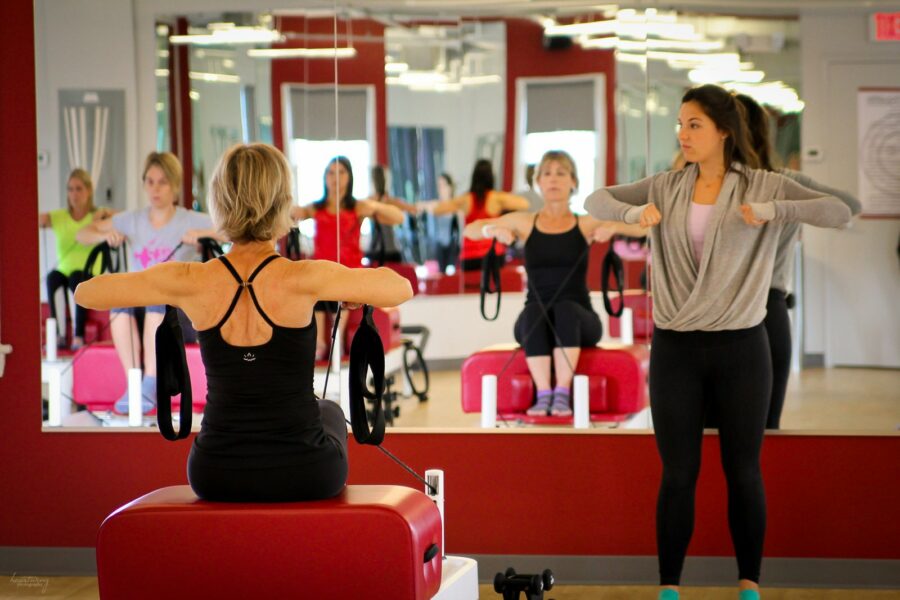When you think of Pilates, you don’t typically think of cardio. Which is fair enough! In general, Pilates is a great whole-body workout focused on strength, flexibility, and alignment in the body, so many of our exercises don’t stem from the goal of an elevated heart rate.
But cardiovascular exercise is an important component of your overall wellness routine, especially for heart health. On top of that, sometimes it’s fun to switch things up – especially in the winter months, when we all need a little jump start.
Enter the jump board!
The jump board is a fantastic addition to any Pilates class to integrate cardio and elevate that heart rate. It can even be used as a central component of classes to balance out strength and conditioning exercises with cardio.
So let’s discuss what the jump board is, exactly, why it’s so great for you, what jump board exercises might look like in a class setting, and how you can try it out with RTR Pilates this winter.
What the jump board is

The jump board is a padded plate that replaces the foot bar on the reformer. Placed at the end of the reformer, it creates a soft platform with some give, which you can then use to “jump” against spring resistance while laying down.
Overall, the jump board is a great non-weight bearing method to increase heart rate. It’s safe, and much easier on the joints than running – no jarring of the knee joints here!
When integrated into a class, the jump board is a fun cardio exercise that challenges your core, elevates the heart rate, and improves coordination.
Jump board exercises and what they do
During jump board exercises in class, the plate allows you to simulate the cardio of jumping, without the impact of actually jumping up and down.
It’s a low-impact exercise that provides an aerobic exercise while protecting your body from the impact of landing. You are “jumping” while lying down. The low impact exercise gives you the aerobic benefit of a rebounder while protecting your knees and back from the jarring impact of landing.
In addition to elevating your heart rate, the jump board can work different muscle groups, depending on your reformer’s settings and your instructors intentions. The spring settings themselves control how quickly you return to the jump board, which will alter its effects.
When using a light spring setting, the jump board can be a fun abdominal workout, because your abs need to work overtime. On a lighter resistance, your abs have to hold your legs up. Typically a light spring setting has a greater focus on endurance, and clients will experience more static holds, hovering in place, and pushing through exercises for a longer period of time.
On the other hand, a heavier spring setting is great for your lower muscle groups. With a heavier resistance setting, you will return to the board faster, which places more emphasis on your quads and the associated muscle groups, while still acting as a low-impact cardio exercise.
Circuit classes featuring the jump board
In the winter months, when running or biking outdoors can become uncomfortable, it’s fun to switch up classes and integrate cardio into your Pilates routine.
At RTR Pilates, we will integrate the jump board into our regular classes for variety. For these regular classes, the jump board exercises will typically take up just 5 minutes of class to increase your heart rate.
For anyone interested in a fuller jump board experience, we also offer our circuit classes throughout the week at our studios.
Our circuit classes utilize the jump board throughout the entire class, alternating regular exercises on the reformer with jump board-specific exercises to keep your heart rate up throughout class. This is a really fun way to switch up your workout routine and integrate some heart-healthy cardio exercise!
If you are interested in attending a circuit class, we typically offer them at each studio, with the class time varying at each location. So if you can’t find a circuit class at a preferred time in your typical studio, be sure to look at the schedules for our other studio locations in the DMV.
? “When it comes to Jump Board I often think of it like a puzzle. I like to give my clients the pieces – jump combinations like the Pilates v, mogul, parallel, and split – one at a time. Then, I give the overall picture, like doing certain variations in a certain order and at a certain pace. This actively engages both the mind and the body. Plus, constantly mixing it up is just straight-up fun.” – RTR Instructor Christopher B.
Can I use the jump board if I have back/knee/ankle pain?
Absolutely – with a doctor’s permission, and depending on the severity of your issue.
The non-weight bearing method of the jump board is excellent for those who have knee and ankle issues. With proper positioning, you should not experience any additional impact on these areas.
Plus, one of the great things about the reformer is that its springs act as a spectrum of support, while still providing an efficient whole-body workout. More springs provide more support, so we can always start with more support and adjust spring settings as you continue to build strength. Clients can always add or take away spring weights to provide additional support or challenge the muscles further.
As always, it’s important to work with your instructor to find the right spring settings that align with your body and your specific fitness goals.
Sign up for a circuit class today!
If you’re ready to try something new and add some fun variety to your workout routine, then our circuit class is for you!



